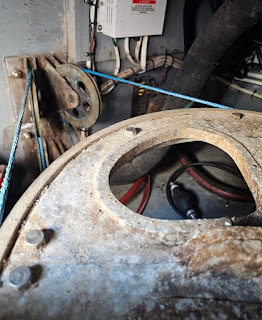Kenny Bishop, Highland Mary 37VT18, has done two innovative things to make his cable steering more robust.
First, grease fittings were installed in some of the sheaves to more effectively lubricate their axles. While the modification isn't difficult to do, the trick is finding a spot to drill through the sheave's mount and into the void around the axle. Once this is done, the hole is tapped and the grease fitting installed.
Kenny's second upgrade was to replace the steel steering cable with a Dyneema cord. (Note: "cord" is the sailors term for rope that has been cut to length to serve a specific purpose). Compared to steel cable, pliable Dyneema is much easier to feed through the sheaves. A simple knot replaces the cable clamps at the quadrant end. Kenny says that the "meat hooks," which abounded on the steel cable and frequently drew blood, are now a thing of the past.
They say proof is in the pudding. Well, the sheave's grease fittings and the Dyneema aboard Highland Mary have been working trouble free for three years. What's really impressive though is how easy and smooth Highland Mary's helm is to turn over. How easy?
Here's the simple test setup used to answer that question. With the tug's engine off, a scale, measuring in pounds, pushes against a spoke until it starts to move. When the spoke moves, the scale's reading is recorded. For Highland Mary it averaged 2.1lb. Compared to two sisterships with cable steering, Highland Mary's helm was 2 to 5 times easier to turn.
In summary, well lubricated sheaves with a light and pliable Dyneema steering cord results in a helm that requires significantly less force to turn.
Dave Howell, ex-Nellie D. 37VT63




No comments:
Post a Comment